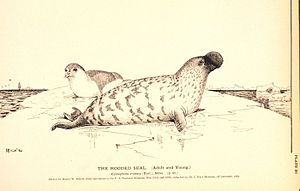Folding cap
| Folding cap | ||||||||||||
|---|---|---|---|---|---|---|---|---|---|---|---|---|

Folding cap ( Cystophora cristata ) |
||||||||||||
| Systematics | ||||||||||||
|
||||||||||||
| Scientific name of the genus | ||||||||||||
| Cystophora | ||||||||||||
| Nilsson , 1820 | ||||||||||||
| Scientific name of the species | ||||||||||||
| Cystophora cristata | ||||||||||||
| ( Erxleben , 1777) |
The cap ( Cystophora cristata ), cap seal or cap seal is an arctic seal , which is named after the cap-like bulge on the forehead and nose of the male.
features
The cap-like attachment is actually a growth on the nose. Instead of hanging down like a trunk like the elephant seal, this strange structure is on the forehead of the male. The "hat" begins to develop in the fourth year of life. It is divided into two parts along the nasal septum. The male can inflate this cap so that the size of his head appears to double in size. The male uses this remedy during the mating season and as a threatening gesture.
The male in the folding cap is about two and a half meters long and weighs 300 kg. Females are smaller: they measure around 2 m and weigh 200 kg. The color is silvery; the body is littered with dark, irregular spots. The head is noticeably darker than the rest of the body and is not spotted.
habitat
The flap hat lives in the arctic seas north of Canada , Greenland and Europe . The distribution area extends from Baffinland over Newfoundland and Iceland to Spitzbergen . Stray individual animals have also been found on the coasts of Great Britain , Portugal and Germany . Hats live on the drift ice above deep layers of water. They avoid the coasts and the pack ice and also give birth to the young on floating ice floes if those of sufficient size and strength are available.
Way of life
Hats are solitary seals that do not form colonies. In March, however, several females come together to give birth in loose groups, with the individual animals at least 50 m apart. When a female raises a cub, it is during this time in the company of a male who is very aggressive towards conspecifics. For the right to protect the female, there can be fights between the male folding hats. They then inflate their "caps" and try to bite each other. The interest of the males lies not only in protecting the young, but also in securing the right to mate with the female after the young have been weaned. Strong males can also guard several females in the vicinity.
The young animals have a bluish coat, they were formerly referred to by the seal hunters as "blue men". They are nursed by the mother for about four to six days, which is the shortest breastfeeding period of any mammal.
The females then leave their young to mate with the waiting male in the water. The young remain alone on the ice for a few weeks, during which time they lose considerable weight and finally go into the water to hunt. Hats eat fish and octopus.
Others
Because of the trans of the old animals and the blue fur of the young, folding hats were slaughtered en masse in the 19th and 20th centuries. In the 1970s, almost 100,000 hat skins were being sold every year . After the USA banned the import of seal skins in 1972 and the countries of Europe in the 1980s , demand fell considerably and stocks have since recovered. Today, an estimated 5,000 folding hats are still killed every year, the species is not threatened. The worldwide population was estimated at 500,000 to 600,000 animals in 1993.
Because of the rampant enlargement of the male's nose, it has often been assumed that the folding cap is related to the elephant seal. Both genera were grouped under the name "proboscis seals". Today this development is considered to be an example of convergent evolution and is no longer viewed as related.
literature
- Ronald M. Nowak: Walker's Mammals of the World. 6th edition. Johns Hopkins University Press, Baltimore 1999, ISBN 0-8018-5789-9
Web links
- Hooded Seal (Cystophora cristata). In: Seal Conservation Society's web site. Retrieved on August 16, 2019 .
- Flap cap in the Wadden Sea
- Cystophora cristata inthe IUCN Red List of Threatened Species 2013.1. Posted by: Kovacs, K. (IUCN SSC Pinniped Specialist Group), 2008. Retrieved October 13, 2013.


